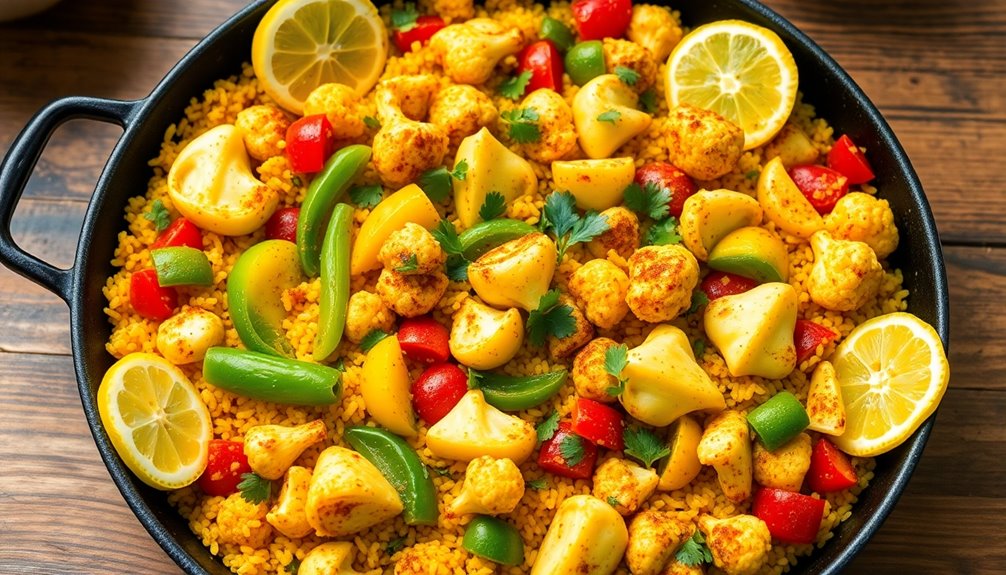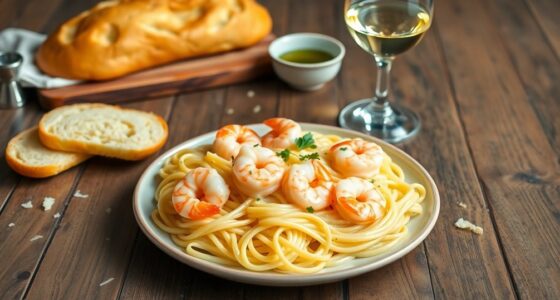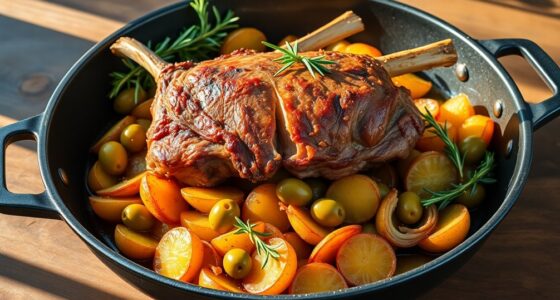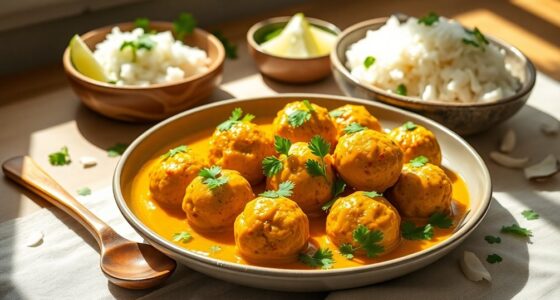Vegetable paella is a vibrant, flavorful dish that hails from the Valencia region of Spain. You can make it by using short-grain rice, fresh seasonal vegetables, and aromatic spices like saffron. The mix of ingredients creates a hearty meal perfect for gatherings. Achieving that signature socarrat, the crispy layer at the bottom, is a thrilling part of the process. If you want to master the recipe and cooking techniques, there's plenty more to discover.
History
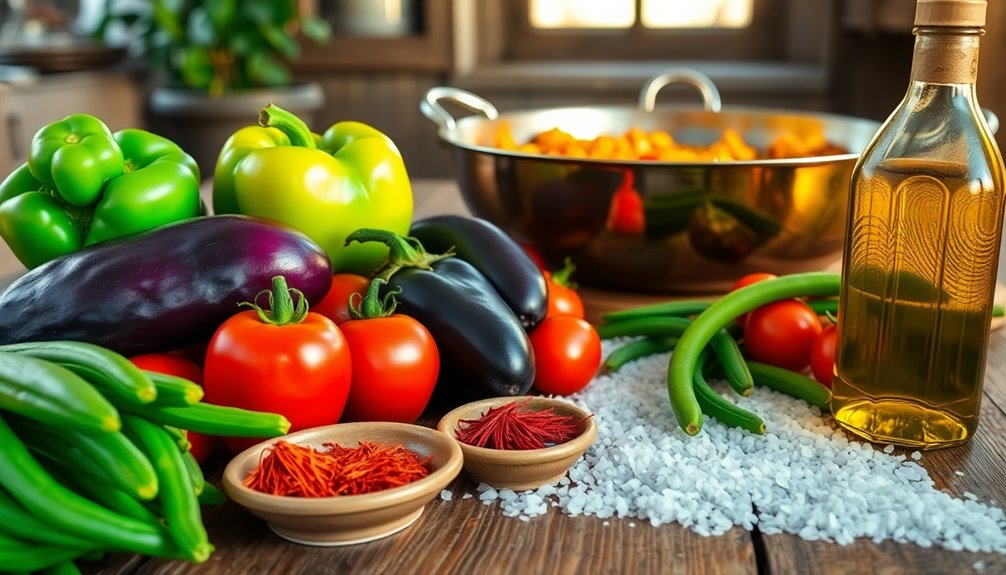
Paella verdura, or vegetable paella, has its roots in the Valencia region of Spain, where local farmers have cultivated rice and a variety of vegetables for centuries.
This dish reflects the area's agricultural practices, showcasing seasonal produce while honoring the Spanish tradition of paella. Historically, while meat often took center stage, the vegetarian version arose to accommodate dietary restrictions and highlight the abundance of local vegetables.
The addition of saffron and smoked paprika enriches the flavor profile, setting vegetable paella apart from other rice dishes.
As a staple of Spanish cuisine, paella verdura has gained international popularity, inspiring adaptations across cultures. Its rich history continues to evolve, celebrating both the land and the flavors it provides.
Recipe
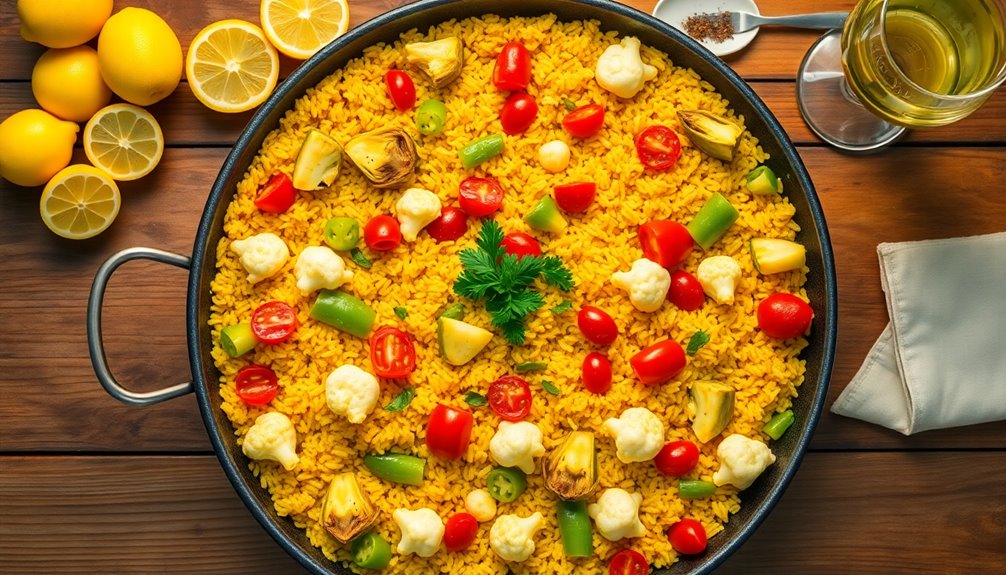
Vegetable paella is a vibrant and flavorful dish that showcases the beauty of fresh vegetables combined with aromatic spices. This vegetarian version of the classic Spanish paella isn't only hearty but also incredibly satisfying, making it a perfect meal for gatherings or a cozy family dinner. The dish is rooted in tradition, featuring a variety of vegetables, a saffron-infused rice base, and the beloved socarrat that gives it the crispy texture at the bottom of the pan.
To prepare vegetable paella, you'll want to start by gathering fresh, seasonal vegetables such as artichokes, cauliflower, and green peppers. The combination of these vegetables along with a savory sofrito will create a rich and delicious dish that's sure to impress. Remember to use short-grain rice varieties like Bomba or Calasparra, as they're ideal for absorbing the flavors of the broth and spices. With the right ingredients and careful cooking, you'll have a delightful paella that embodies the essence of Spanish cuisine.
Ingredients:
- 2 cups short-grain rice (Bomba or Calasparra)
- 4 cups vegetable broth
- 1 medium onion, finely chopped
- 3 cloves garlic, minced
- 1 medium tomato, diced
- 1 cup artichoke hearts, quartered
- 1 cup cauliflower florets
- 1 cup green peppers, diced
- 1 teaspoon smoked paprika
- 1/2 teaspoon saffron threads
- 1 teaspoon dried oregano
- Salt and white pepper to taste
- Olive oil for sautéing
- Fresh parsley for garnish (optional)
- Lemon wedges for serving (optional)
In a large paella pan or a wide skillet, heat a drizzle of olive oil over medium heat. Add the chopped onion and minced garlic, sautéing until softened and fragrant. Stir in the diced tomato and cook for a few minutes until it breaks down into a sauce.
Next, add the artichokes, cauliflower, and green peppers, sautéing for another 5 minutes. Sprinkle in the smoked paprika, saffron threads, oregano, salt, and white pepper, stirring well to combine. Pour in the vegetable broth, bringing the mixture to a gentle boil.
Once boiling, add the rice, stirring it in, then reduce the heat and let it simmer uncovered without stirring for about 20 minutes, or until the rice has absorbed most of the liquid. Allow the paella to rest for another 5 minutes, then heat it over medium-high heat for a couple of minutes to create the socarrat. Serve garnished with fresh parsley and lemon wedges.
When preparing vegetable paella, it's important to keep an eye on the liquid levels as the rice cooks; if it seems too dry, you can add a little more broth or water. Remember, the key to achieving the socarrat isn't to stir the rice once the broth is added, allowing it to form a crispy base.
You can customize your vegetable selection based on what's in season or your personal preferences, so feel free to experiment with other vegetables like peas, zucchini, or asparagus. Enjoy your delicious homemade paella!
Cooking Steps
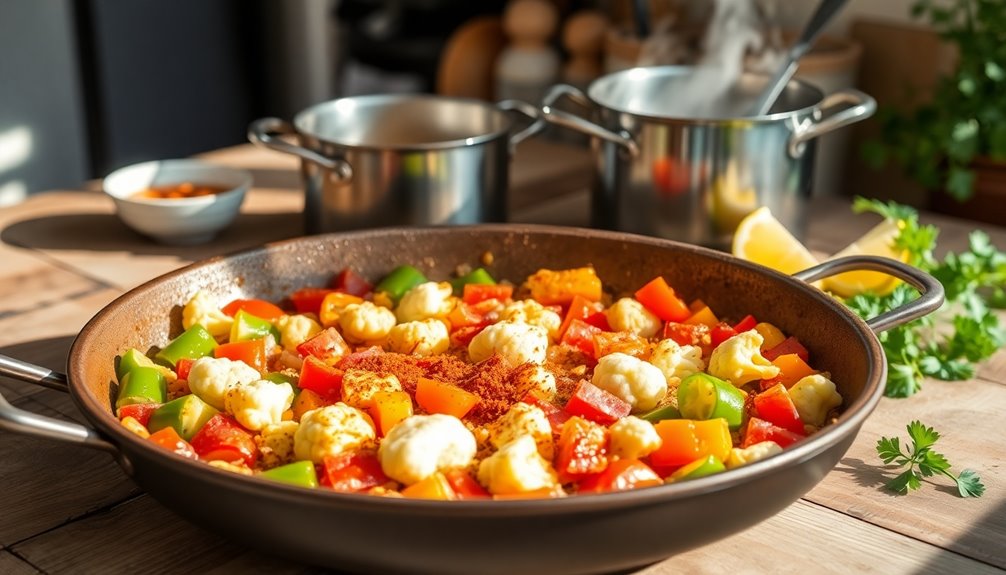
To kick off your vegetable paella, gather fresh seasonal vegetables and chop them into bite-sized pieces.
Don't forget to add your favorite spices for flavor, enhancing the dish's overall taste.
Once everything's prepped, you'll simmer the veggies until tender before adding broth and stirring gently to combine.
Step 1. Gather Fresh Seasonal Vegetables
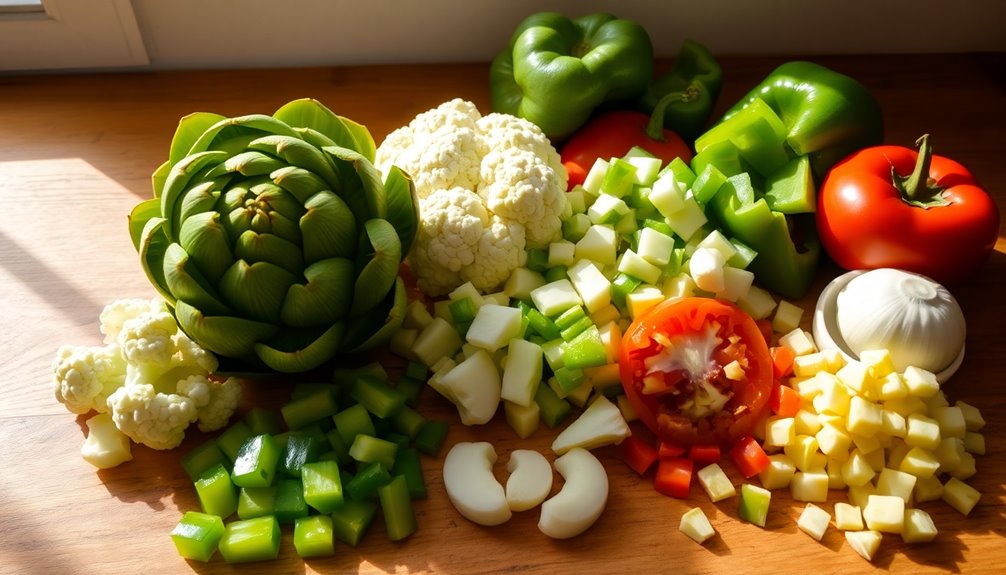
When you're gathering fresh seasonal vegetables for your paella verdura, it's crucial to focus on hearty options that really boost the dish's flavor and texture.
Look for firm artichokes and a medium to large head of cauliflower, guaranteeing the florets are chunky for that crisp-creamy experience. Don't forget to include vibrant green Italian peppers or small green bell peppers for added color.
Spring or baby garlic can offer a milder flavor. For protein and texture, incorporate diverse beans like bajoqueta and garrofn, or opt for green beans and canned butter beans.
Always wash and dry your fresh seasonal vegetables thoroughly, as this guarantees maximum freshness and flavor when combined with your vegetable broth in the paella verdura.
Step 2. Chop Vegetables Into Bite-Sized Pieces
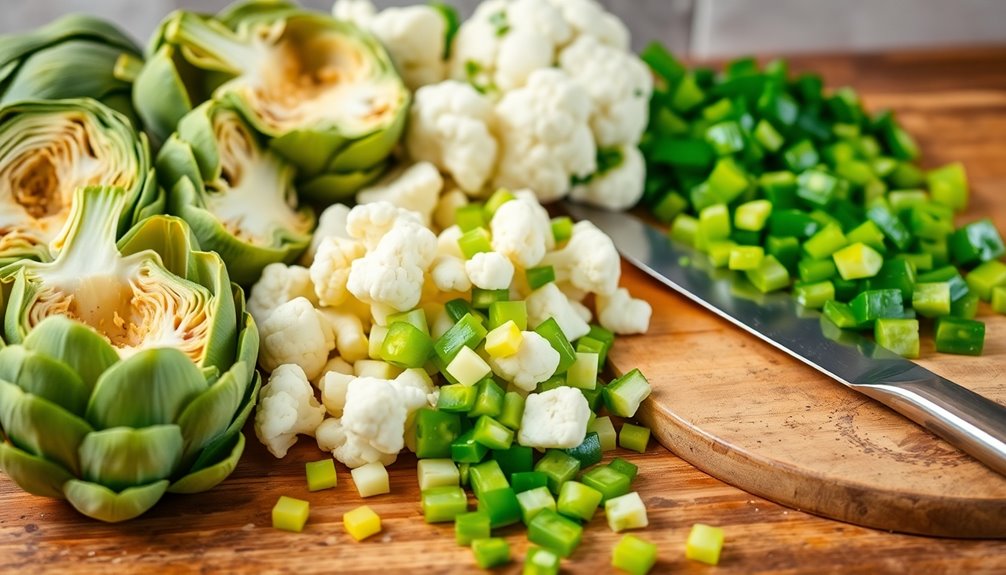
As you prepare the vegetables for your paella, chopping them into bite-sized pieces guarantees even cooking and enhances the overall texture of the dish.
Start by washing and drying your vegetables thoroughly. Cut artichokes in half, remove the inner hairs, and slice them thinly. For the cauliflower, break it into chunky florets, which will add a nutty flavor.
Slice green peppers into long strips after removing the seeds to boost their sweetness. Dice onions finely and chop spring garlic into chunks; these are important ingredients that will integrate beautifully into the sofrito base.
Layer the chopped vegetables in your pan over medium heat, allowing each to shine while contributing to the rich, vibrant flavors of your paella. Additionally, using fresh ingredients can enhance overall development by providing essential nutrients that support cognitive growth and learning.
Step 3. Add Spices for Flavor
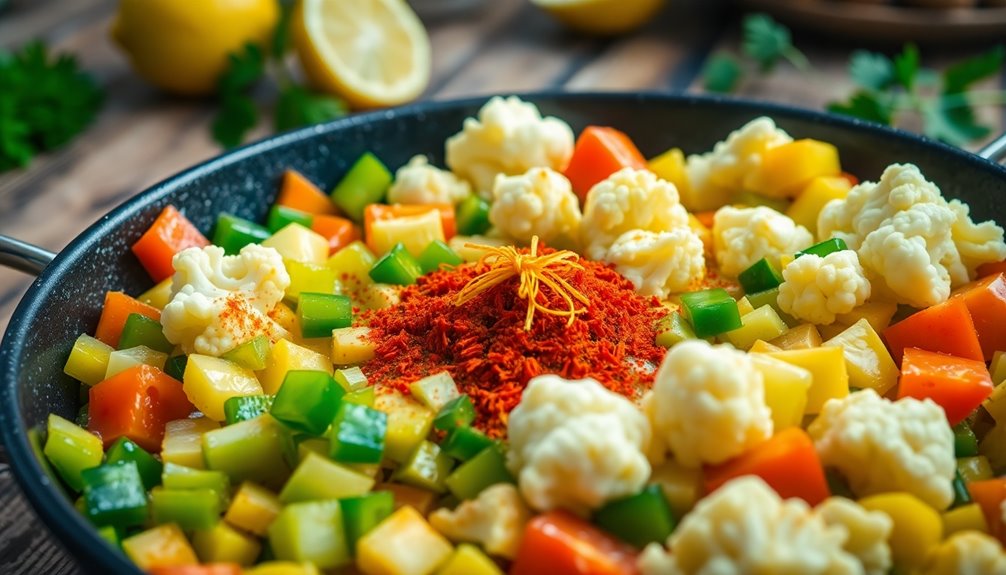
Adding spices is essential for elevating the flavor of your vegetable paella. Start by incorporating smoked paprika, which adds a distinct smokiness that beautifully complements the vegetables.
Next, use saffron threads soaked in hot water; this will impart a gorgeous golden hue and a subtle aroma. For a hint of heat, consider adding a pinch of cayenne pepper or red pepper flakes to balance the sweetness of the veggies.
Don't forget to mix in some dried oregano during cooking for earthy notes. For extra umami, include a small amount of tomato paste in your sofrito.
Finally, add fresh herbs like parsley at the end for a burst of freshness, completing your flavorful vegetable paella masterpiece. Additionally, incorporating protein-rich ingredients can further enhance the dish's nutritional profile and flavor complexity.
Step 4. Simmer Until Tender
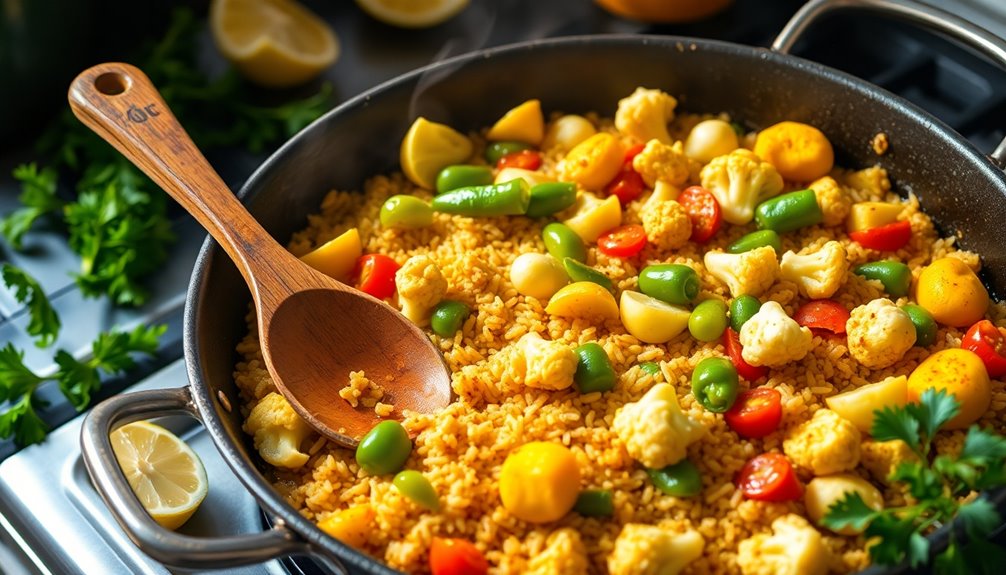
To achieve perfectly tender rice in your vegetable paella, simmer it uncovered after adding the rice. This step is essential for even cooking and allows the grains to absorb the liquid, resulting in a moist yet separate texture.
Keep the heat high for about 15 minutes, ensuring most of the liquid is absorbed. Avoid covering the pan too early, as it might leave you with undercooked grains; too late, and you risk mushiness.
After cooking, let the paella rest for 5-10 minutes. This resting time helps crystallize the starches, enhancing the overall texture and creating that desirable socarrat at the bottom.
Don't forget to drizzle in a bit of olive oil for extra richness!
Step 5. Add Broth and Stir Gently
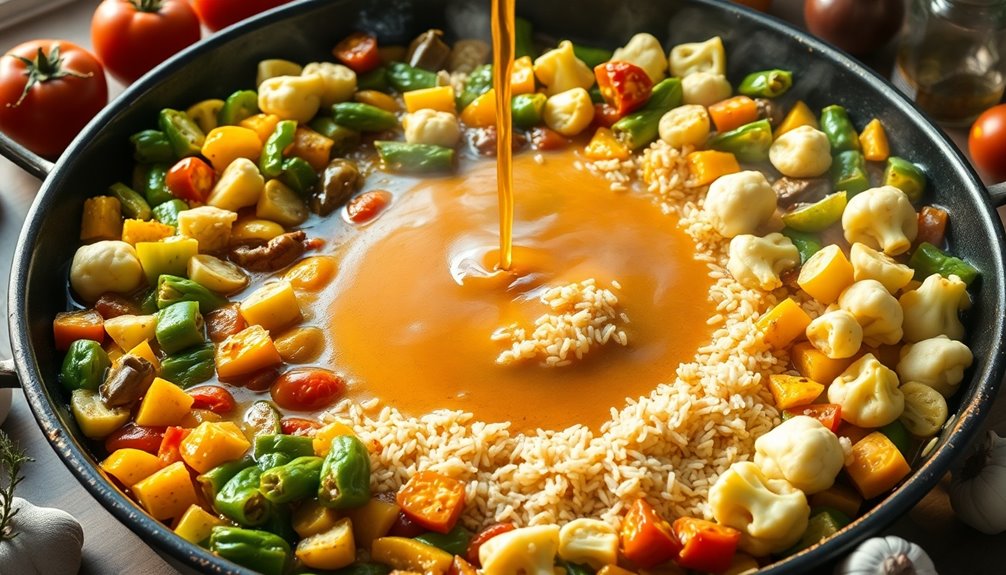
Once your vegetables are cooked to perfection, pour in the prepared vegetable broth, making sure it covers the rice evenly for ideal absorption.
At this stage, add the saffron infusion, ensuring it's evenly spread throughout the liquid.
Stir gently just once to distribute the ingredients without disturbing the rice too much. This helps maintain the desired texture for your vegetable paella.
After stirring, bring the mixture to a boil, then reduce the heat to let the rice simmer.
Avoid stirring again; this allows the liquid to be absorbed properly and promotes the formation of the socarrat, the prized bottom layer.
Enjoy the process as your paella transforms into a delicious masterpiece!
Final Thoughts
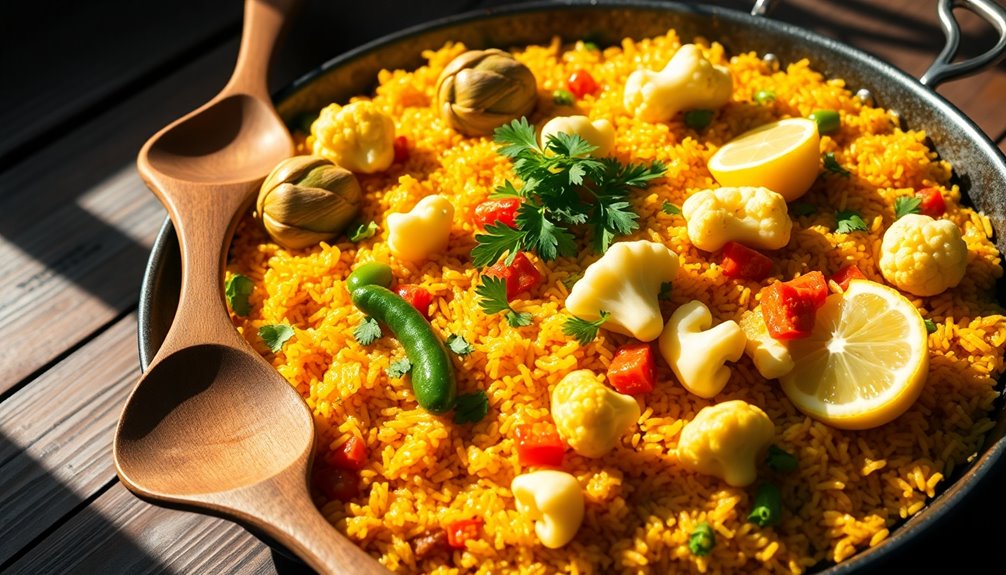
While preparing vegetable paella might seem intimidating, the rewards are well worth the effort. This dish highlights the freshness of hearty vegetables like artichokes, cauliflower, and green peppers, creating a delightful flavor profile.
Using short-grain white rice, such as Bomba or Calasparra, guarantees a tender yet separate texture, perfect for absorbing rich flavors. Remember to choose saffron threads for that authentic touch, though they're optional.
Achieving a delicious socarrat, the prized crispy rice layer at the bottom, is a thrilling finale to your cooking adventure. Plus, vegetable paella is incredibly versatile, making it an excellent choice for vegetarian, vegan, and gluten-free gatherings.
Frequently Asked Questions
What Is Paella Verdure?
When you think of a vibrant, colorful dish that celebrates the bounty of nature, you might find yourself wondering about vegetable paella.
It's a delightful blend of various vegetables and perfectly cooked rice, all infused with rich flavors.
Imagine the harmony of artichokes, peppers, and spices coming together in a single pan.
This dish isn't just a meal; it's an experience worth sharing, inviting you to savor every bite with loved ones.
What Are the Three Main Types of Paella?
The three main types of paella are Paella Valenciana, Paella de Marisco, and Paella de Verduras.
In Paella Valenciana, you'll find rabbit, chicken, and green beans, reflecting its traditional roots.
If you love seafood, Paella de Marisco, with shrimp and mussels, is perfect for you.
For a vegetarian option, Paella de Verduras showcases seasonal vegetables, offering a fresh take on this classic dish.
Each type brings unique flavors and ingredients to your table.
What Is the Secret Ingredient in Paella?
The secret ingredient in paella is often considered to be saffron. It gives the dish its unique flavor and vibrant yellow color, making it stand out.
You'll also want to focus on incorporating smoked paprika for that depth and smokiness. A well-made sofrito, packed with garlic, tomatoes, and peppers, serves as the flavorful base.
Finally, using high-quality broth instead of water will elevate the overall taste of your paella greatly.
What Is Vegetarian Paella Made Of?
Picture a vibrant medley of artichokes, zucchini, and colorful peppers simmering in a fragrant broth.
That's vegetarian paella for you! You've got short-grain rice absorbing all those rich flavors, thanks to a classic sofrito of sautéed onions, garlic, and tomatoes.
Smoky paprika and a hint of saffron elevate the dish, while chickpeas and peas add a hearty touch.
Feel free to mix in seasonal veggies to make it truly your own!
